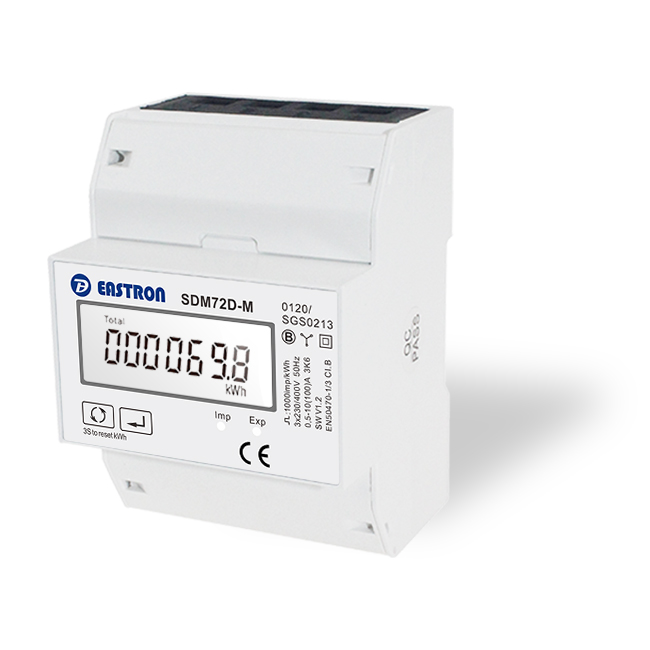Product Consultation
Your email address will not be published. Required fields are marked *
Three-phase MID Energy Meters are designed to measure not only energy consumption but also a variety of electrical parameters essential for efficient energy management and system monitoring.
How it's measured: Three-phase energy meters continuously monitor the line-to-line and line-to-neutral voltages across all three phases. By using high-precision voltage sensors, these meters track voltage levels to detect fluctuations or abnormalities.
Why it’s important: Voltage measurement is crucial for assessing the overall health of the power supply, ensuring that the system operates within safe and efficient voltage levels. It helps prevent damage to equipment due to overvoltage or undervoltage conditions.
How it's measured: Current is measured by current transformers (CTs) that are installed around each phase conductor. These transformers provide proportional signals based on the flow of current, which are then processed by the energy meter.
Why it’s important: Measuring current allows the energy meter to calculate total power consumption and identify overcurrent conditions, which could lead to equipment damage or indicate inefficient operation.
How it's measured: Three-phase MID energy meters measure both active power (kW) and reactive power (kVAR) by using voltage and current readings from all three phases. Active power refers to the actual energy being used, while reactive power represents the energy that oscillates between the source and the load, contributing to the system’s overall load.
Why it’s important: Monitoring both active and reactive power is essential for understanding real energy consumption and ensuring that the system operates efficiently, minimizing reactive power losses.
How it's measured: Power factor is calculated by comparing active power to apparent power (the total power flowing through the system). A power factor close to 1 indicates efficient energy usage, while lower values suggest the presence of excessive reactive power.
Why it’s important: A low power factor indicates poor energy efficiency and may lead to higher electricity costs, especially in industrial and commercial settings. By measuring the power factor, the energy meter helps identify opportunities for correction, such as the addition of power factor correction devices (e.g., capacitors).

How it's measured: Frequency is typically measured by analyzing the alternating current (AC) signal. The meter monitors the number of cycles per second (Hz), which is an indicator of the stability of the grid’s power supply.
Why it’s important: Frequency deviations can affect the performance of electrical equipment and machinery. The standard grid frequency is typically 50 Hz or 60 Hz, depending on the region, and large variations could indicate grid instability.
How it's measured: Energy meters equipped with advanced signal processing can measure Total Harmonic Distortion (THD) in voltage and current. Harmonics are distortions in the electrical waveform caused by non-linear loads, such as computers, LED lights, and certain types of motors.
Why it’s important: High harmonic distortion can cause overheating, efficiency loss, and premature failure of equipment. Monitoring THD helps to ensure that the electrical system is operating in a way that minimizes harmonic interference.
How it's measured: Energy meters can track peak demand over a set period (such as daily, weekly, or monthly) by recording the highest level of energy usage within that timeframe.
Why it’s important: Tracking peak demand allows operators to manage load shedding and optimize energy usage to avoid exceeding contractual limits or incurring additional costs due to high demand charges.
How it's measured: Three-phase MID meters can separately measure active energy (kWh), apparent energy (kVAh), and reactive energy (kVARh) over time.
Why it’s important: Tracking these separate energy types helps with accurate billing, energy auditing, and identifying areas for energy efficiency improvement. For example, minimizing reactive energy can reduce unnecessary strain on the power grid.
How it's measured: Modern energy meters can store load profiles to capture the consumption patterns of a facility over time. This typically involves collecting data on energy usage at different intervals (e.g., hourly or minute-by-minute).
Why it’s important: Understanding the load profile is essential for optimizing energy consumption, scheduling equipment usage during off-peak hours, and managing demand response strategies.
How it's measured: Many advanced energy meters are equipped with data logging capabilities that record events such as power outages, voltage dips, overcurrent events, or power factor drops.
Why it’s important: By tracking these events, operators can diagnose issues, improve system reliability, and take corrective action before problems become critical.
Your email address will not be published. Required fields are marked *
We develop and produce high performance electricity meters, power analyzers, current sensors, communication modules and management systems. China Custom Smart Meters Manufacturers and Factory
Eastron China (HQ) : NO 52, Dongjin Road, Nanhu, Jiaxing, Zhejiang, China
Eastron UK : Suite 1 Cornwallis House, Howard Chase, Basildon, UK
Eastron EU : Unit 3 Finglas Business Centre, Jamestown Road, Finglas, Dublin, Ireland
Copyright @ Eastron Electronic Co., Ltd. All rights reserved Electricity Meters Manufacturers
